Best Violin Shoulder Rests: From Beginner to Pro Levels
Affiliate Disclosure
This post may contain affiliate links. If you buy through them, I may earn a small commission at no extra cost to you. This helps support the site and keeps our content free for you.
If you prefer not to use affiliate links, you can search products directly on the maker’s site.
A good violin shoulder rest makes a major difference in how comfortably you hold your instrument. It matters for posture, ease of playing, and avoiding pain in your shoulder or neck. Musicians often say that the wrong rest can lead to tension and tired arms.
This guide will show you the best options for every level, from your very first lesson to a professional stage. We’ll break down what makes each one great, and by the end, you’ll know exactly which one is right for you. (Hint: Our top all-around pick is a classic for a reason).
A Quick Look: Our Top Picks for 2025
| Product Name | Image | Best For | Stability Rating | Key Feature | Check Price |
|---|---|---|---|---|---|
| Everest EZ |

| Beginners & Budgets | 4/5 | Simple, sturdy, and comfortable foam. | Price |
| Kun Original |
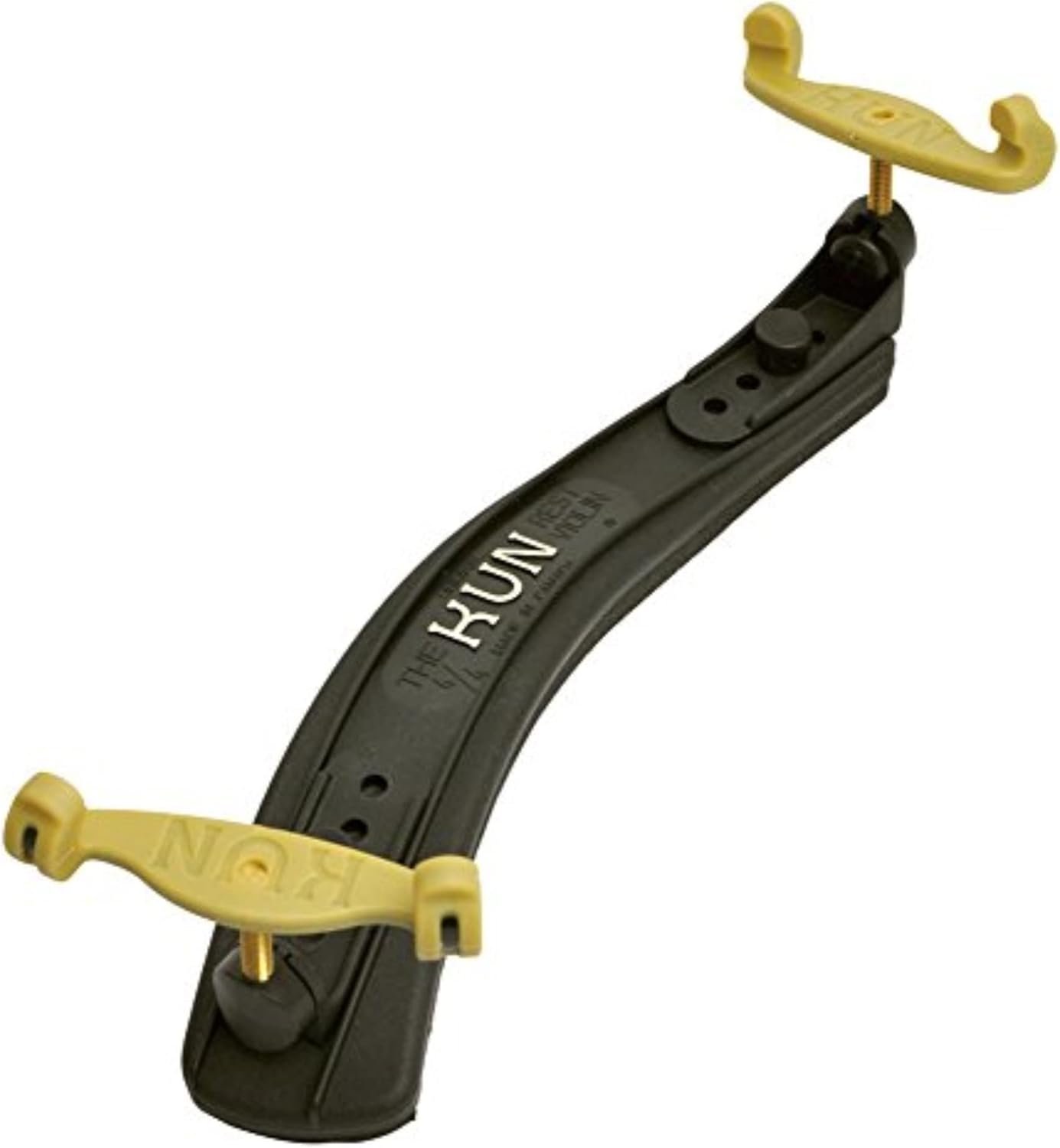
| The All-Rounder | 4.5/5 | Classic design, great adjustability. | Price |
| Bonmusica |
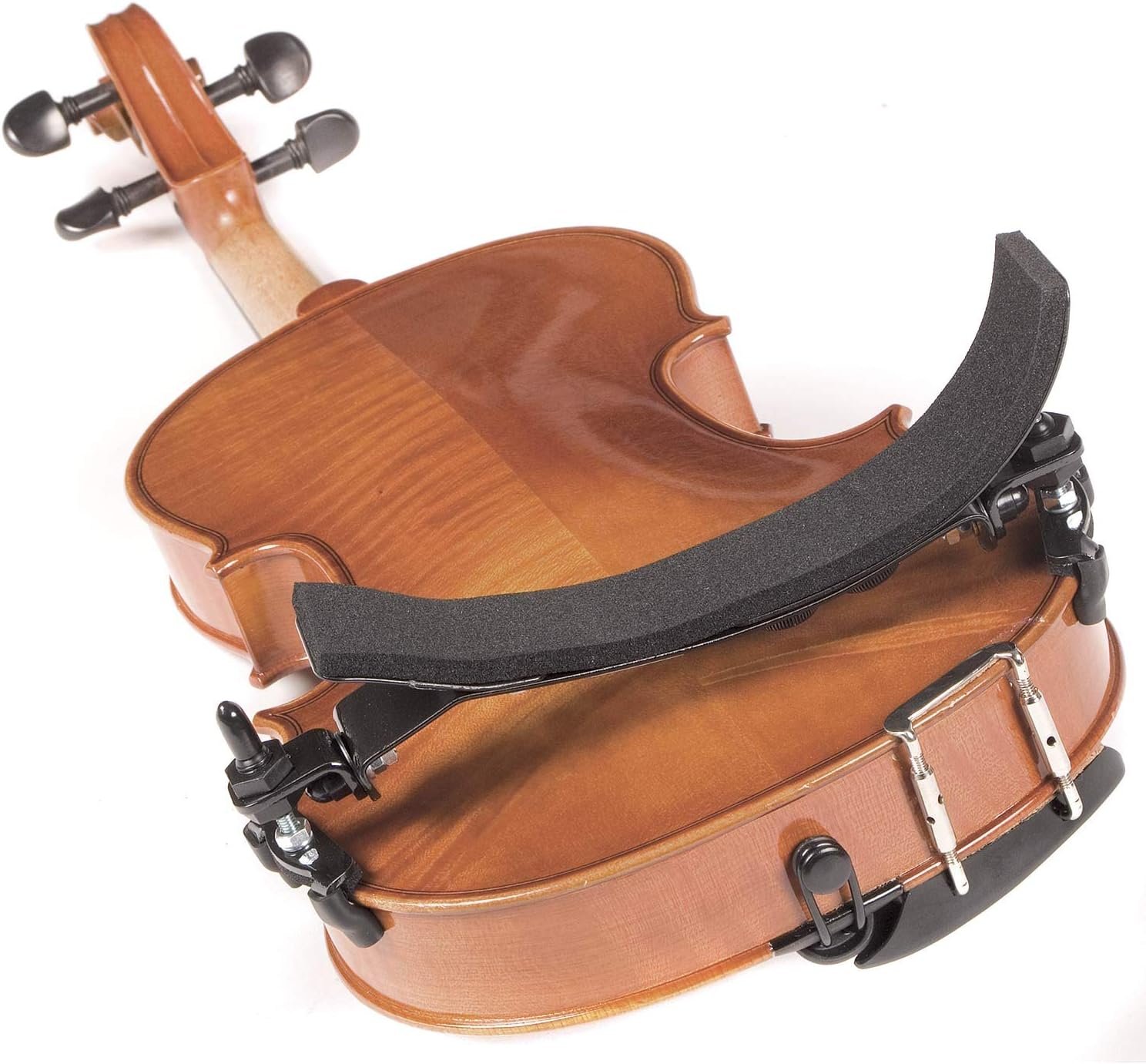
| Maximum Security | 5/5 | Bendable metal “hook” grips the shoulder. | Price |
| Wolf Forte Secondo |
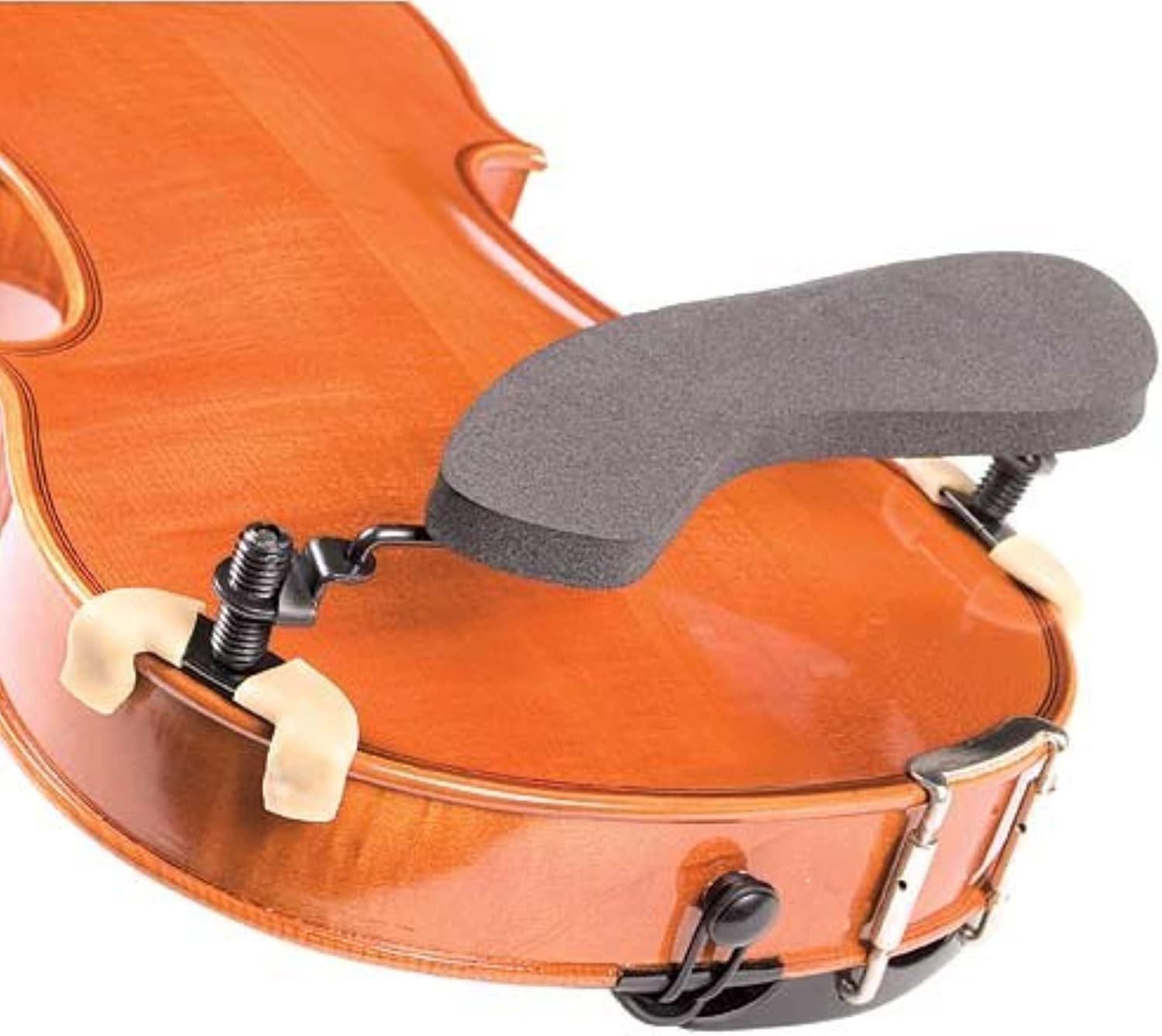
| Ultimate Adjustability | 4/5 | Bendable bar, plus wide height/tilt range. | Price |
| Pirastro KorfkerRest |

| Professionals | 5/5 | Ultra-lightweight, bendable tonewood. | Price |
In-Depth Violin Shoulder Rest Reviews
We tested these rests for comfort, stability, sound, and ease of use. Here’s the detailed breakdown.
1. Everest EZ Shoulder Rest

Overview
The Everest EZ is one of the most popular recommendations for a violin shoulder rest for beginners, and for good reason. It’s simple, affordable, and very comfortable right out of the box. It’s a no fuss design made from a strong plastic body with a thick foam pad.
Key Features
- Ergonomic Shape: The body of the rest is curved to match the slope of your shoulder.
- Thick Foam Padding: Provides a comfortable cushion that new players love.
- Simple “Grippers”: The feet are simple and hold onto the violin well, with less risk of slipping than some other models.
Our Take
The Everest is all about comfort and simplicity. We love it for students because there aren’t many confusing parts to adjust. You just set the width for your violin (it fits 4/4 and most 3/4 sizes) and it’s ready to go. The thick foam is very forgiving and helps you get used to the feel of the instrument.
It’s not the most adjustable rest. You can change the height a bit by swapping the grippers, but you can’t really change the angle or tilt. For 90% of beginners, this is perfectly fine. It’s a huge step up from a “sponge and rubber band” and provides the stable support you need to learn good posture.
| Pros | Cons |
|---|---|
| Very affordable | Limited adjustability (no tilt) |
| Extremely comfortable foam | Can feel a bit bulky in some violin cases |
| Durable and hard to break |
Best for: Beginners, students, and anyone wanting a simple, comfortable, and budget friendly option.
2. Kun Original Shoulder Rest

Overview
If you walk into any orchestra, you will see the Kun Original. It’s the “Honda Civic” of shoulder rests: reliable, popular, and it just works. It set the standard for the modern adjustable violin shoulder rest. Its simple, wishbone-like shape is light and fits most people well.
Key Features
- Patented Folding Feet: Many Kun models (like the Kun Collapsible) have feet that fold down, making it easy to fit in your case.
- Three-Direction Adjustability: You can easily change the height, width, and tilt.
- Lightweight Body: You barely notice it’s there, which helps the violin’s sound.
Our Take
The Kun is our top all around pick. It’s the perfect balance of price, comfort, and features. The ability to change the tilt is a big deal. You can angle it to sit perfectly between your shoulder and collarbone. This is something the Everest can’t do.
The feet are simple screws, so you can make one side higher than the other. This helps fit the rest to your specific body shape. The feet also pivot, helping them grip the violin’s edges. Some players find the foam a bit thinner than the Everest’s, but it’s a very dense, high quality padding that lasts for years.
| Pros | Cons |
|---|---|
| Excellent adjustability for the price | The screw-style feet can loosen over time |
| Lightweight design is good for sound | Foam is firm, not as “cushy” as the Everest |
| Collapsible models are very convenient |
Best for: Students, intermediate players, and anyone who needs a reliable, adjustable rest that will last for years.
3. Bonmusica Violin Shoulder Rest
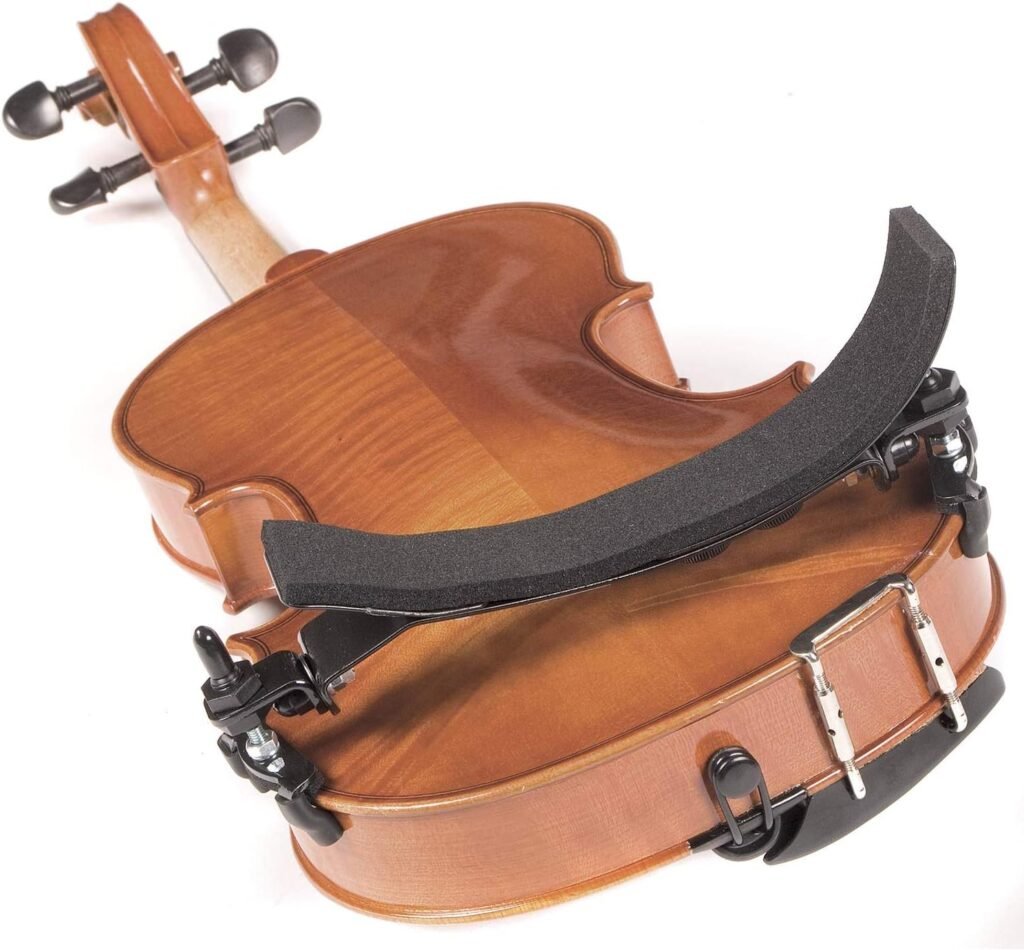
Overview
The Bonmusica is in a category of its own. It looks completely different from other rests because it’s made of a bendable metal bar covered in foam. It has a “hook” that wraps over your shoulder, locking the violin in place. If you have ever felt your violin slipping, this is your answer.
Key Features
- Malleable Metal Base: You can physically bend the entire rest to perfectly match your shoulder, chest, and collarbone.
- “Hook” Design: The curved end wraps over your shoulder, providing unmatched stability.
- Highly Adjustable: Every part can be changed, height, width, tilt, and the curve of the body itself.
Our Take
This is the best violin shoulder rest for security. When you put this on, the violin is not going anywhere. This is amazing for players who move a lot or who have sloped shoulders. It gives an incredible sense of confidence. It’s also a lifesaver for people with long necks, as it can be adjusted very high.
The downside? It’s heavy. All that metal adds weight. Some players also feel it’s too secure, like the violin is “clamped” to their body and they can’t move as freely. You also have to bend it to find your perfect shape, which can take some time. But once you find your fit, it’s amazing.
| Pros | Cons |
|---|---|
| Unbeatable stability; the violin will not slip | Heavier than plastic or wood rests |
| Infinitely adjustable to your body’s shape | Can be hard to fit in a violin case |
| Great for long necks and sloped shoulders |
Best for: Players with sloped shoulders, long necks, or anyone who wants the most secure, locked-in feeling possible.
4. Wolf Forte Secondo Shoulder Rest
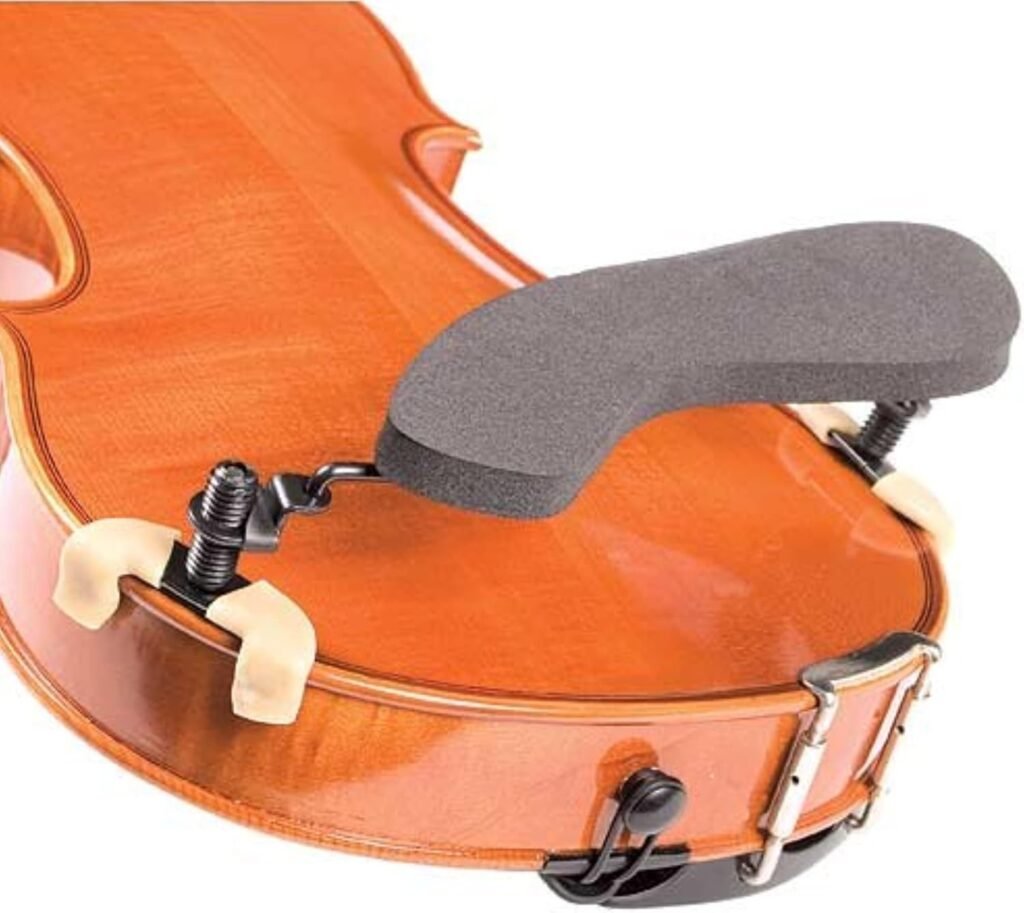
Overview
The Wolf Forte Secondo is another classic, loved by professionals for its amazing adjustability. Like the Bonmusica, it has a bendable metal bar. However, it does not have the “hook,” which many players prefer. It offers the custom fit of a metal rest but with more freedom of movement.
Key Features
- Bendable Aluminum Bar: You can shape the rest to your shoulder’s curve.
- Wide Range of Adjustments: This rest can be set very high or very low, and the tilt can be changed a lot.
- Curved Shape: The rest itself is curved, which helps it fit comfortably.
Our Take
This is the top choice for people who can’t seem to find a good fit with “standard” rests like the Kun. The main feature is the bendable bar. You can add a curve, take a curve out, or even add a slight “S” shape to make it fit you perfectly. This is a level of customization you just can’t get from plastic rests.
Some players find the screw mechanisms a bit “flimsy” compared to a Kun, and it can take time to get all the adjustments right. But it’s lighter than the Bonmusica and offers that same custom-fit feeling. It’s an excellent piece of violin accessories for comfort.
| Pros | Cons |
|---|---|
| Bendable bar for a truly custom fit | Can be “shaky” if not tightened well |
| Lighter than the Bonmusica | Adjustments can be complex for a beginner |
| Very wide height and tilt range |
Best for: Advanced students and professionals who need a custom, ergonomic fit without the “hook” of a Bonmusica.
5. Pirastro KorfkerRest Model 2
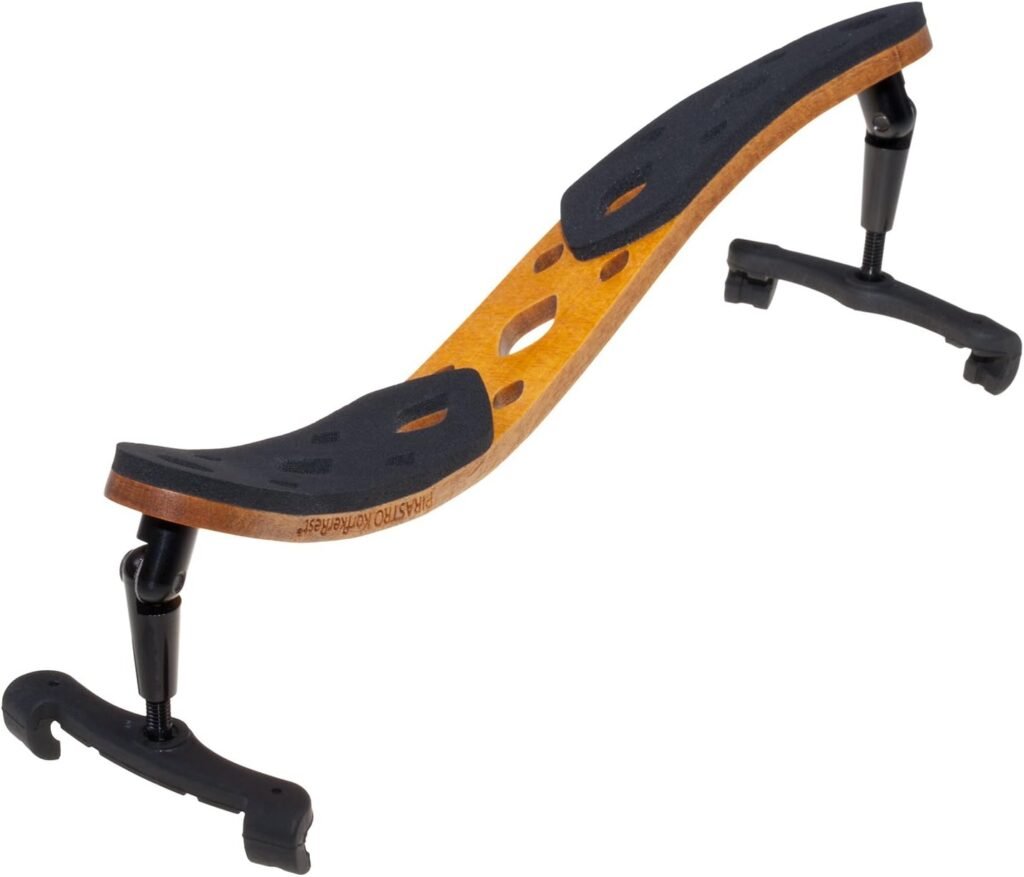
Overview
This is the “sports car” of violin shoulder rests. The KorfkerRest is for professionals who want the absolute best. It is made of a special bendable tonewood (yes, wood!) and is so light you will forget it’s on your violin. The goal of this rest is to be as light and flexible as possible, so it doesn’t dampen the violin’s sound.
Key Features
- Ultra-Lightweight: At just 32 grams, it’s one of the lightest rests in the world.
- Bendable Tonewood: You can gently bend the wood to shape it to your shoulder.
- Minimalist Design: It uses tiny, secure feet that have very little contact with the violin, improving sound.
Our Take
Playing with the KorfkerRest is a different experience. The violin feels more alive and resonant. Because it’s so light, it feels like there is almost nothing there. You can bend it to get a perfect fit, and it holds its shape.
This rest is a serious investment. It is very expensive. It also has a learning curve. Bending the wood feels scary at first, and you have to be patient to find your perfect shape. This is not a rest for a beginner, but for a professional or advanced player, it is the best you can get.
| Pros | Cons |
|---|---|
| Incredibly lightweight | Extremely expensive |
| Improves the violin’s sound and resonance | Has a learning curve to adjust properly |
| Fully bendable for a custom, ergonomic fit |
Best for: Professional violinists, concert artists, and anyone who wants the lightest, most resonant rest and is willing to invest in it.
How to Choose Your Violin Shoulder Rest: A Guide
This section is your violin shoulder rest guide. Picking a rest is very personal. What works for your teacher might not work for you. Here’s what to look for.
1. Why Do You Need a Shoulder Rest?
A violin shoulder rest does one main job: it fills the space between your jaw and your shoulder/collarbone.
- Good Posture: Without a rest, many people tilt their head down or lift their left shoulder up. Both of these habits cause muscle strain, neck pain, and tension.
- Stability: It helps grip the instrument so your left hand is free to move, shift positions, and play with vibrato.
- Comfort: It stops the hard wood of the violin from digging into your collarbone during long practice sessions.
2. The Chin Rest Connection
STOP! Before you buy a shoulder rest, check your chin rest.
This is the most important secret. Your chin rest and shoulder rest work as a team. If your chin rest is too low, you’ll try to fix the problem with a very high shoulder rest, which can be unstable.
Your goal is to hold the violin with your head in a natural, upright position. Your chin rest should be tall enough that you can just turn your head and rest your jaw in it. Then, the shoulder rest just fills the remaining gap.
3. Understanding Adjustments
- Height: This is the most important adjustment. It depends on your neck length. Most rests are adjustable, but some (like Bonmusica and Wolf) can go much higher than others.
- Width: This lets the rest fit the body of your violin. All rests are adjustable for width to fit 4/4 or 3/4 violins.
- Tilt: This is the angle of the rest. Being able to tilt the rest forward or backward lets you fit it to the slope of your shoulder. This is a key feature of the Kun and Wolf rests.
- Shape (Ergonomics): This is where it gets personal. Plastic rests (Everest, Kun) have a fixed shape. Metal/wood rests (Bonmusica, Wolf, Korfker) are bendable, letting you create a custom ergonomic shape.
4. Materials Matter
- Plastic: Lightweight, strong, and affordable. The most common material. (Everest, Kun).
- Metal: Heavier, but allows the rest to be bent for a custom fit. (Bonmusica, Wolf).
- Wood: Often lighter than plastic and looks beautiful. Some players feel it sounds better. (Kun Bravo, Mach One).
- Carbon Fiber: Very strong and very light, but also expensive.
- Tonewood: The high tech, flexible wood used in the KorfkerRest. It’s designed for resonance and is extremely light.
5. How to Fit a Violin Shoulder Rest
Here is a quick guide to getting a secure fit.
- Start with the Chin Rest: Make sure your chin rest is comfortable and the right height for you first.
- Attach the Rest: The rest attaches to the widest part of the violin’s back (the lower bout). The side that is lower or less curved usually goes on the side of the E-string (your right side, or chest side). The higher or more curved side goes on the G-string side (your left, or shoulder side).
- Set the Height: Put the violin on your shoulder. Your head should be straight, not tilted down. Adjust the height of the rest so it just touches your body. You should be able to hold the violin with just your jaw and shoulder, without shrugging your shoulder up.
- Check for Gaps: There should be no big gaps between the rest and your body. If there are, you may need to adjust the tilt or bend the rest (if it’s a metal model).
- Test It: Play a simple scale. You should feel secure, but not tense. You shouldn’t have to “squeeze” with your chin to hold the violin.
Our Final Recommendation
Choosing a violin shoulder rest is a journey, but it’s worth it.
For the best all around option, we recommend the Kun Original. It offers the best mix of adjustability, comfort, and value. It works for beginners, advanced students, and even many professionals. It’s the standard for a reason.
If you are a total beginner on a budget, the Everest EZ is a wonderful, comfortable, and simple choice to get you started on the right foot.
The most important thing is to find a rest that makes playing feel easy and natural. Don’t be afraid to try a few until you find the one that fits your body.
Would you like a similar guide on how to choose the right violin chin rest?
FAQ: Best Violin Shoulder Rests
1. Do I really need a violin shoulder rest?
Yes, most beginners should use one. A shoulder rest makes it much easier to hold the violin with good posture. It helps prevent neck and shoulder pain while you learn.
2. How do I know what size violin shoulder rest to get?
The rest size should match your violin size. If you have a full-size (4/4) violin, get a 4/4 rest. If you have a 1/2 size violin, get a 1/2 size rest. Most are adjustable.
3. How do I put on a violin shoulder rest?
Turn the violin over. Attach the rest’s “feet” to the widest part of the violin’s back. The higher or more curved side usually goes on your shoulder, while the lower side rests on your chest.
4. Can you play the violin without a shoulder rest?
Yes, some advanced players do, but it’s much harder. For beginners, a shoulder rest is the best way to learn good posture and stay comfortable and relaxed.
5. Why does my shoulder rest keep slipping?
This usually happens for three reasons:
The rubber feet are old or dirty (try cleaning them).
The rest is not adjusted to fit the angle of your shoulder.
Your shirt fabric is too slippery.
